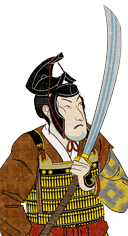
Basic Unit Statistics (can be modified by difficulty level, arts, skills, traits and retainers)
| Recruitment Cost | 550 | |
| Upkeep Cost | 100 | |
| Melee Attack | 10 | 28% |
| Charge Bonus | 15 | 30% |
| Bonus vs Cavalry | 0 | 0% |
| Melee Defence | 2 | 5% |
| Armour | 3 | 20% |
| Morale | 6 | 12% |
Strengths & Weaknesses
- Good in melee.
- Very good charge.
- Good morale.
- Vulnerable to cavalry and archers.
Abilities
- Banzai - This unit can enter into a frenzied state for a short period of time, temporarily increasing its speed, charge and melee attacks, and making it unbreakable.
Requires
Description
These powerful shock troops are deadly when they charge home, and excellent in close combat.
Sword attendants are armed with a large powerful swords, impressive weapons that require the strength of both arms to wield effectively in battle. This gives the attendants a fearsome appearance as they charge forward to engage in close combat. Two-handed swords are incredibly sharp and can easily cut through enemies, while the flat sides of the blades can deflect enemy blows. Sword attendants go into battle accepting death and fearing little, but accepting your death and foolishly risking life and limb are not the same thing. They must be wary of threats from cavalry and missile troops, against which they are vulnerable if mishandled. The skill and craftsmanship of Japan's swordsmiths is almost beyond compare. Perhaps only the swords from the forges of Toledo and Dasmascus matched the beauty of Japanese blades, but they did not quite match the sophisticated metallurgy of the Japanese. During the Gempei War the katana, or more correctly, tachi of later centuries had still to develop and become recognised as the classic samurai sword. The skills of the swordsmith were, however, already in evidence. Gempei period swords were just as deadly as their later Sengoku Jidai equivalents when used by an expert.